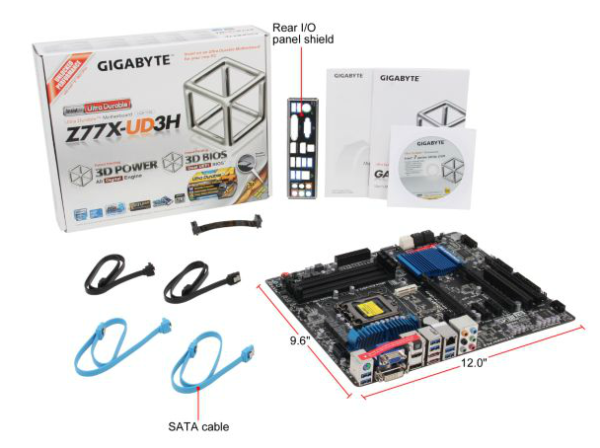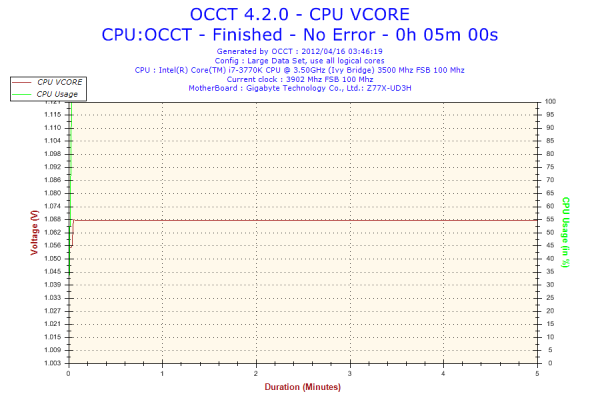Intel Z77 Motherboard Review with Ivy Bridge - ASRock, ASUS, Gigabyte, and MSI
by Ian Cutress on May 7, 2012 7:40 PM EST- Posted in
- Motherboards
- MSI
- Gigabyte
- ASRock
- Asus
- Ivy Bridge
- Z77
Gigabyte GA-Z77X-UD3H - In The Box
Over the past several motherboard generations, I have not been that impressed with Gigabyte's offering in terms of extras - this is because in order to hit a price point, sometimes the extras in the box are not the focus of the product. With the Z77X-UD3H, we are hoping for at least some good stuff here.
Driver CD
User Manual
IO Shield
Four SATA Cables
One long SLI bridge
Voltage Readings
Using OCCT we monitor the voltage change of the motherboard under load. This represents the direct correlation between the Load Line Calibration and how the processor/motherboard deals with voltage requests while under load. This is not to be confused with the quality of power delivery, but more an indication of how aggressive the default LLC settings are on a motherboard.
The response of the Gigabyte board under load is fantastic. No ripple at all and a lower average voltage than the ASUS P8P77-V Pro.
Overclocking
Note: Ivy Bridge does not overclock like Sandy Bridge. For a detailed report on the effect of voltage on Ivy Bridge (and thus temperatures and power draw), please read Undervolting and Overclocking on Ivy Bridge.
The Gigabyte GA-Z77X-UD3H has a variety of overclocking tools at the disposal of the user. Automatic overclocks are through EasyTune6, where we experienced a rather good result with our chip with Gigabyte's auto tuning software, and manual overclocks are either performed through the BIOS (with a series of menu jumps which should have been more carefully laid out), or using a new Gigabyte tool called TweakLauncher. I have not previewed TweakLauncher here, as it is primarily for sub-zero overclockers wanting real-time access to changes in performance while under extreme temperatures. It forgoes the usual GUI interface and sliders with something more amenable to the competitive overclocker - it is not suitable for the majority of users.
Auto Overclock: Using the Auto Tuning option in EasyTune6, the software pulled up a large screen and offered a confirmation of a stress-tested overclock. When clicked yes, the system would stability test a range of BCLK and Multipliers until the board resets or the system finds it unstable. When this had finished, the board offered me a 46x104.5 overclock (4810 MHz). I discovered that turbo modes still applied, so this speed was the single thread speed, and the CPU would reduce the multiplier by two for multithreaded loads, giving 4589 MHz). This gave 1.236 volts at load, which could be a little high, but due to the lower speed under multithreaded load, the CPU only reached 84ºC under PovRay and was completely stable. I enjoyed this result a lot from an automatic overclock!
Manual Overclock: Due to the way Ivy Bridge behaves with increased voltage, for a manual overclock, I am testing the peak overclock at a variety of voltages as well as the temperatures at that voltage. On the Gigabyte board, the CPU load line calibration was set to Extreme and Intel Speed Step was disabled. One interesting thing to note was that Gigabyte set this board to 100.9 MHz default on the BCLK, rather than 100.0 MHz. When the multiplier is pushed above 44x, this is reduced to 100.0 MHz.
At 1.100 volts, the highest multiplier that was stable was 45x, giving 4.5 GHz. This gave 70ºC at load with PovRay, and showed a load voltage of 1.116 volts.
At 1.150 volts, the highest multiplier that was stable was 46x, giving 4.6 GHz. This gave 75ºC at load with PovRay, and showed a load voltage of 1.164 volts.
At 1.200 volts, the highest multiplier that was stable was 47x, giving 4.7 GHz. This gave 82ºC with PovRay, 86ºC with OCCT, and a load voltage of 1.212 volts.
At 1.250 volts, the board successfully booted at 4.8 GHz, with 1.272 volts under load and 89ºC with PovRay - but this was not stable due to the memory errors in PovRay, suggesting more voltage is required. Given the current load temperature, I was unwilling to push the voltage further.
In terms of memory, when attempting to overclock a G.Skill 2x4 DDR3-2666 kit, which performed 2950 MHz on the ASUS P8Z77-V Pro, it would not boot at the DDR3-2800 strap despite all the correct timings being entered.












117 Comments
View All Comments
hasseb64 - Wednesday, May 9, 2012 - link
My last build was with a Z68 ATX MB, such a build will never happen again in my house. Next update will have Micro-ATX or maybe even a Mini-ATX.During my 15 years of computer building I have never used more than 1 GPU
In next computer I will probably not use any more expansion, today I have a old SB card installed.
And 2 slots for memory will do too (2x8 GB)
All HDDs are in separate WHS2011 box
ATX feels more and more like a thing of the past, these Taiwan makers are holding on as it seems but the future for them are to deliver smaller packages = less money.
ggathagan - Thursday, May 10, 2012 - link
For the vast majority of folks, you are correct, and the board manufacturers are also catering to that market.There are, however, plenty of people that *do* have multi-GPU systems.
Further, there are more uses for PCIe than just GPU's; RAID controllers, 10GbE NIC's, and high end sound cards, to name a few.
Zoomer - Tuesday, May 15, 2012 - link
To be honest, with GPUs these days, 7 slots seem to be not enough. 2 slots are needed for the GPU, 3 for semi-decent cooling, particularly for these darn open air coolers manufacturers like to use for some reason.Sysiphus - Wednesday, May 9, 2012 - link
Is it possible to control 3pin fans on this boards? I didnt see a option and the asus board has only 4pins. Chassisfans are normally 3pinned.kstan12 - Wednesday, May 9, 2012 - link
i own the asus p8z77-v pro. i have plugged my rear chassis & side panel fans into the 4 pin connectors on the mobo and i can control them with fan expert 2.i bought a few of these:
http://www.newegg.com/Product/Product.aspx?Item=N8...
Zoomer - Tuesday, May 15, 2012 - link
Can they be controlled via speedfan?mcquade181 - Thursday, May 10, 2012 - link
You can plug 3 pin fans into 4 pin MB connectors.ggathagan - Thursday, May 10, 2012 - link
Under the "ASRock Z77 Extreme4 - Overview" section you mention XFast USB twice.The second time should be XFast RAM
Under the "Visual Inspection" section for the MSI Z77A-GD65:
"Underneath this are the eight SATA ports - two SATA 6 Gbps from the PCH, four SATA 6 Gbps also from the PCH, and another two SATA 6 Gbps from an ASMedia controller."
I believe it should be "four SATA 3 Gbps also from the PCH...".
Under "Updates to our Testing Methodology"
"Also with experience allows us to pick tests ..."
Should be "Also, experience allows us to pick tests ..."
Under the conclusion section for the ASRock Z77 Exteme4:
"The XFast LAN software also shows superior performance in incompressible transfers or real-world transfers compared to standard USB throughput."
Should be "XFast USB software..."
All that aside, great review.
I appreciate the effort you and the rest of the Anandtech staff put in to improving your test processes.
I especially appreciate this multi-board approach that highlights the key differences across a series of boards that use the same chipset.
It certainly helps when making purchasing decisions.
Nickel020 - Thursday, May 10, 2012 - link
You say in the conclusion that you gain voltage read points by going withe MSI over the Gigabyte - the Gigabyte though does in fact also have voltage read points, just a less convenient implementationAs for the review: I realize that there are time constraints and you can't do one of the in-depth reviews that we sometimes got in the past, but I would like to see a more convenient user oriented layout, e.g. tables comparing the features of the boards, a table comparing the OC results etc. The way the review is structures i have to take a look at every board seperately, take notes and then compare them. Also some more comments on how the tested models compare to other models of the same manufacturers would be nice. Doesn't take much time, but greatly helps someone shopping around for a board.
Lastly, I'm highly skeptical of the software voltage readings but I know that many people do take such software readings as absolute truth, not realizing their potential flaws. You seem reasonably skeptical as well, and this is something I think should be mentioned in the review to prevent misunderstandings.
FozzyofAus - Thursday, May 10, 2012 - link
Hi guys,Any change you could review the:
AsRock z77 Professional-M
In addition to the previously requested:
AsRock z77 Extreme4-m
Thanks in advance,
Michael.